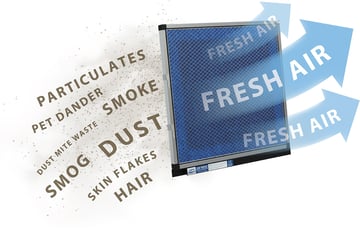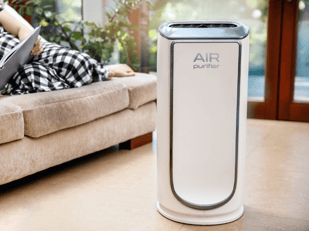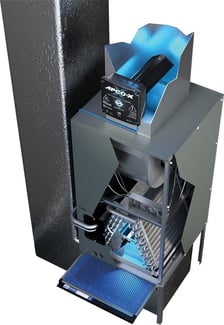Recently, we have all had good reason to learn about the quality of the air we breathe. If the past 18 months have taught us nothing else, it’s that there can be unseen and un-smelled dangers lurking in the air we breathe.
Locking yourself up at home for months may have gotten you wondering just how safe the air inside your home really is. Are there are things in your home’s air that may harm you or make you sick? If so, are there indoor air quality solutions available to solve this problem for you?
The answer to both questions is yes.
How are harmful pollutants introduced into your home?
Sure - the thought of viruses polluting the air inside your home is not a pleasant one, but they make up only a very small portion of the potentially harmful things found in most homes’ air. Many of the products used in normal everyday activities like cleaning products, cosmetics, personal care items, and smoking tobacco can leave residual particles behind that can be damaging to your health.
Sometimes the things you do to improve your home and décor add indoor air pollution as well. New furniture and rugs, paint, and even blinds and drapes may contain toxins that find their way into the air that you breathe. Dust created from remodeling and other household projects can linger in the air.
Fireplaces or wood stoves that are not well vented, appliances that do not run properly, and/or certain ingredients used in cooking have the potential to release irritating, and sometimes harmful, particles into the air. Excess moisture in your bathrooms or basement can also promote the growth of mold and mildew, which release spores into the air. Let’s not forget that outdoor pollution will likely find its way into your home, adding to what already exists inside.
It sounds frightening, but it doesn’t have to be. There are many indoor air quality solutions that can, to a greater or lesser degree, rid your home of most of the unpleasant or dangerous particles in your air.
The Problems with Poor Indoor Air Quality
The higher the number of chemical or biological particles in your home’s air, the greater the risk of adverse side effects. These problems may occur shortly after exposure or show up years later and include:
- Asthma and other lung-related problems
- Sinus and throat irritation and swelling
- Nausea and digestive issues
- Skin rashes
- Other allergic reactions

Every day spent breathing in indoor air pollution increases the chances of these issues happening. The average American spends 90% of their time indoors and that those most at risk of developing problems, the elderly, the very young, and those with other health issues, tend to spend even more time than that inside and are particularly susceptible to poor air quality.
All of this adds up to the need for effective indoor air solutions.
Types of Indoor Air Quality Solutions
Air filters have been the standard for cleaning the air inside the home for many years, but recently, some new technologies have created other effective options. Not all types of indoor air quality solutions remove all types of contaminants, but all can help to improve the overall quality of the air in your home.
Air Filters
 Almost everybody is familiar with the concept of air filters. They can be found in your heating and air conditioning appliances as well as in portable air filtering devices. High-quality filters, like HEPA filters, have many layers and are designed to filter out even the smallest of particles. They can do a great job of filtering out many of the harmful elements in your home’s air as long as they are replaced or cleaned regularly.
Almost everybody is familiar with the concept of air filters. They can be found in your heating and air conditioning appliances as well as in portable air filtering devices. High-quality filters, like HEPA filters, have many layers and are designed to filter out even the smallest of particles. They can do a great job of filtering out many of the harmful elements in your home’s air as long as they are replaced or cleaned regularly.
Ultraviolet Light
Ultraviolet light does not help to remove any harmful particles from your home’s air, but it does act as a germicide, removing the threat of biological contaminants. These are usually placed in areas that remain damp, like inside your HVAC system, to neutralize mold, mildew, or bacteria that thrive in those conditions.
UV is not a total solution to improve indoor air quality, but when used as part of a complete indoor air quality system it can make a huge difference. To learn more about how UV lights work, read our blog post, "An Introduction to UV Light for HVAC."
Air Purifiers
 Air purifiers can be small units that clear the air in a single room or large enough to purify the air in the whole house. They may use filters designed to trap even the smallest of particles or use an electrostatic charge to cause the particles to fall out of the air.
Air purifiers can be small units that clear the air in a single room or large enough to purify the air in the whole house. They may use filters designed to trap even the smallest of particles or use an electrostatic charge to cause the particles to fall out of the air.
Humidifiers and Dehumidifiers
Depending on where you live and the time of year, the quality of the air in your home may be adversely affected by the amount of moisture in it. Too high and you will feel sticky and bad odors will linger longer. Too low and you may suffer from sinus problems and dry skin. Adding a humidifier to moisten dry air or a dehumidifier to dry out moist air, to your air quality system will help keep you comfortable and healthy.
Saving Money May Be Costly to Your Health
Each of these types of air quality solutions comes in a range of prices, and as with many things, it may be tempting to go with the cheapest choice. This may not be a wise decision.
Although you may save a bit of money now, the cheaper alternatives are usually less expensive for a reason: they are not as effective. For example, A cheaper air filter for your furnace may seem like a logical choice, but let's look into the reality a bit deeper. A low-cost air filter will only filter out the larger particles from your home's air. While it may take care of dust and pet hair, it will not remove bacteria, viruses, or odor-causing chemicals and VOCs. Left to float around in your home's air, these contaminants can be inhaled by you and your loved ones. Inhaling these contaminants can lead to health issues mentioned earlier.
Another example is choosing not to add a dehumidifier to your home's air quality system. This decision may save you some money but lead to damp areas in your home. These areas can become breeding grounds for mold and mildew which has shown to negatively impact the health of those who breathe them in.
When you consider the many negative side effects of breathing contaminated air, you have to ask yourself: is it worth the risk to you and your family to go with the cheaper but less effective indoor air quality solution?
A Complete Solution
 A combination of effective air filters and the APCO-X air treatment system may provide you with one of the most effective indoor air solutions available. Not only does the APCO-X's UVC light safely neutralize biological contaminants in the air and within the air-conditioning system, its proprietary EverCarbon cells remove odors and VOCs.
A combination of effective air filters and the APCO-X air treatment system may provide you with one of the most effective indoor air solutions available. Not only does the APCO-X's UVC light safely neutralize biological contaminants in the air and within the air-conditioning system, its proprietary EverCarbon cells remove odors and VOCs.
To find out more about APCO-X and how it can increase your quality of life by decreasing the air pollution in your home, contact FreshAireUV.com.